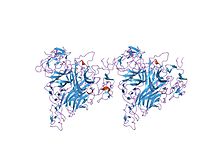| Tumor necrosis factor superfamily | |||||||||
|---|---|---|---|---|---|---|---|---|---|
 Trimeric structure of TNF alpha, produced by Mus musculus, based on PDB structure 2TNF (1.4 Å Resolution). Different colors represent different monomers. Baeyens, KJ et al. (1999).[1] Figure rendered using FirstGlance Jmol. | |||||||||
| Identifiers | |||||||||
| Symbol | TNF | ||||||||
| Pfam | PF00229 | ||||||||
| InterPro | IPR006052 | ||||||||
| PROSITE | PDOC00224 | ||||||||
| SCOP2 | 1tnf / SCOPe / SUPFAM | ||||||||
| OPM superfamily | 292 | ||||||||
| OPM protein | 2hew | ||||||||
| Membranome | 80 | ||||||||
| |||||||||
| TNF | |||||||||
|---|---|---|---|---|---|---|---|---|---|
 crystal structure of trail-sdr5 | |||||||||
| Identifiers | |||||||||
| Symbol | TNF | ||||||||
| Pfam | PF00229 | ||||||||
| Pfam clan | CL0100 | ||||||||
| ECOD | 10.3.1 | ||||||||
| InterPro | IPR006052 | ||||||||
| PROSITE | PDOC00561 | ||||||||
| SCOP2 | 1tnr / SCOPe / SUPFAM | ||||||||
| |||||||||
The tumor necrosis factor (TNF) superfamily is a protein superfamily of type II transmembrane proteins containing TNF homology domain and forming trimers. Members of this superfamily can be released from the cell membrane by extracellular proteolytic cleavage and function as a cytokine. These proteins are expressed predominantly by immune cells and they regulate diverse cell functions, including immune response and inflammation, but also proliferation, differentiation, apoptosis and embryogenesis.[2][3]
The superfamily contains 19 members that bind to 29 members of TNF receptor superfamily.[4] An occurrence of orthologs in invertebrates hints at ancient origin of this superfamily in evolution.[2]
The PROSITE pattern of this superfamily is located in a beta sheet in the central section of the protein that is conserved across all members.
- ^ Baeyens KJ, De Bondt HL, Raeymaekers A, Fiers W, De Ranter CJ (April 1999). "The structure of mouse tumour-necrosis factor at 1.4 A resolution: towards modulation of its selectivity and trimerization". Acta Crystallographica Section D. 55 (Pt 4): 772–8. Bibcode:1999AcCrD..55..772B. doi:10.1107/s0907444998018435. PMID 10089307.
- ^ a b The evolution of the immune system: conservation and diversification. Amsterdam: Elsevier. 2016. ISBN 978-0-12-801975-7. OCLC 950694824.
- ^ Abbas AK, Lichtman AH, Pillai S (May 2017). Cellular and molecular immunology (Ninth ed.). Philadelphia, PA. ISBN 978-0-323-47978-3. OCLC 973917896.
{{cite book}}: CS1 maint: location missing publisher (link) - ^ Aggarwal BB, Gupta SC, Kim JH (January 2012). "Historical perspectives on tumor necrosis factor and its superfamily: 25 years later, a golden journey". Blood. 119 (3): 651–65. doi:10.1182/blood-2011-04-325225. PMC 3265196. PMID 22053109.